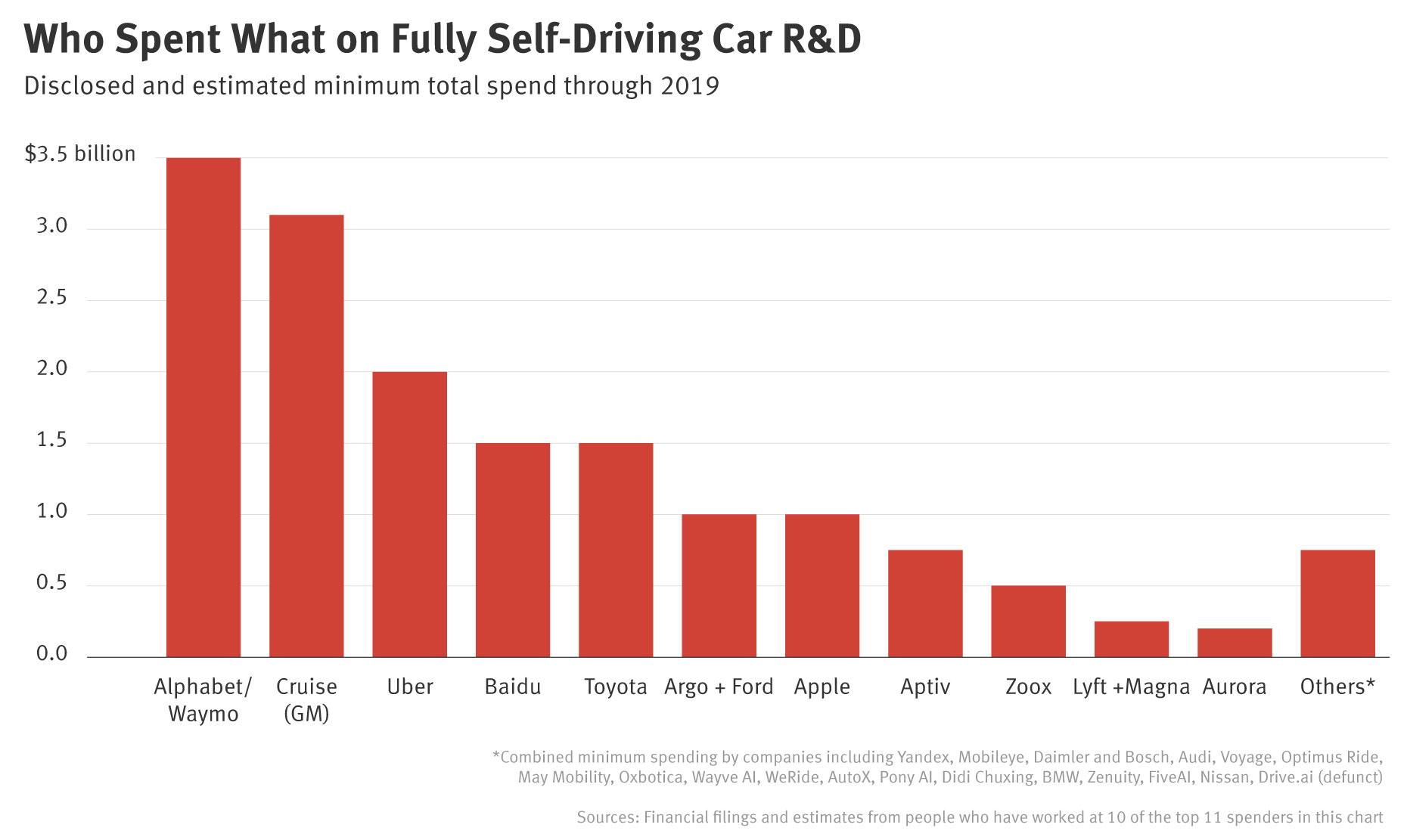Companies spend $ 16 billion on drones to capture 8 trillion market

A recent study published in the technical publication, The Information, estimates that various companies spent about $ 16 billion on projects related to unmanned vehicles. In the article, this situation is called the “money pit” (access to the material is paid, but the table with most of the information is published in the public domain). Waymo and GM / Cruise spent the most – $ 3 billion each, while the acquisitions of large companies are not fully accounted for (for example, Intel spent $ 16 billion on MobilEye, and most of their cost is associated with their unmanned vehicle projects).
The amount seems astronomical, especially in light of the expected decrease in enthusiasm in the near future regarding the rapid development of unmanned vehicle technology by large automakers. 
Self-propelled transport unit from General Motors.
One of the manufacturers that have retained their enthusiasm is GM. Dan Amman, Cruise’s CEO, said on a recent investor day that unmanned vehicle market could be about $ 8 trillion a year: 5 trillion will be passenger riding, 2 trillion for freight and 500 billion for technology related to user experience, and data.
The figure of 8 trillion roughly corresponds to my own calculations regarding land transport around the world. Of course, in order to achieve such market values, the majority of land vehicles must be transferred to self-government, which ultimately will happen, but not in the coming decades. Nevertheless, the sums forming the total investment of $ 16 billion are comparable to drops in the sea in comparison with potential income. But despite such huge numbers and a future so flexible for changes, it is difficult to predict anything for sure. Let’s look at points that are not included in these numbers:
Pioneers have no guarantee of success
All companies spend large sums of money because they hope that the one who wins this race will receive the lion’s share of the market, and the costs will be justified. However, as we have already seen, pioneers are far from always winning in the world of high technologies. Microsoft was the first, Apple was one of the first, but Facebook, Google and Amazon were not the first in their fields.

In the area of robotic taxis, everyone was encouraged by the fact that when you sell trips instead of cars, you also sell a whole chain of transport. You sell a car, fuel / energy, service, insurance, operating experience information and all the rest for a single price, your company becomes a car manufacturer, a retail supplier, an oil, insurance and transport company all rolled into one. A company that works with clients (now Uber and Lyft) controls cash flow. Nowadays, when good autopilot systems are rare, companies driving autonomous driving systems can take over customers. But it is possible that this will not always be the case.
In the early days of the introduction of robotic taxis, competition will be minimal. Each company will begin to deploy its infrastructure city by city, and they will strive to cities without competition instead of competing with another player already present in the city. Perhaps by the end of this period of competition several technological stacks for driving will appear, and it will be more difficult to capture the whole world.
There will be more trips, and their price will fall
Automating car rides will lower their cost. In particular, the cost of their most basic and widespread type will be reduced – short city trips for one person. This type includes 80% of all trips, and it can be served using small and inexpensive vehicles, and during peak hours trips can be shared. Cheaper vehicles and the combination of passengers on a trip will lead to lower prices. In addition, today owning a personal car requires a large upfront cost, which is too high for most people around the world.
The good news for the automotive industry is that if you do something cheaper and remove the basic upfront costs, more people will be able to afford it and they will buy it, so with a decrease in the price of transport, its sales will increase. That is why the figure of 8 trillion can grow.
Significant Bonus Benefits
According to my estimates, Americans spend a total of about 50 billion hours driving each year. Given the average salary in the United States (about $ 35 per hour) we get $ 1.7 trillion of useful time, which will be returned every year only to the United States. According to preliminary calculations, the global cost of this time is $ 5 trillion, while Americans drive ¼ of the total distance traveled, and their contribution is more than a quarter. However, compliance with the total price paid for road transport around the world is respected.
Unmanned vehicles will not eliminate all accidents, but they will not be released until they drive safer than people, and over time they will become more and more safe. In 2014, the US National Highway Traffic Safety Administration calculated that road accidents cost Americans $ 871 billion a year in total. Again, no one has made an estimate for the whole world, but it will range from 3 to 4 trillion dollars. Even halving accidents will provide amazing benefits (in fairness, driver assistance technologies in conventional cars will also reduce the number of accidents, so most of these benefits will come to us anyway).
New revolutions are coming
Some pioneers believe that ground transportation was a mistake, and personal transportation should aim in the air. Sebastian Trun, the most respected pioneer in the field of unmanned vehicles, for the most part abandoned work in this area, and now assures that all the action will take place in the air – due to computerized electric aircraft with vertical take-off. Air transport offers an almost unlimited number of “lanes” in three dimensions, while infrastructure costs are negligible (compared to land transport), and the speed of movement is higher.
All this is just one of the predictions for decades to come, which can become a reality. There are others that people have yet to think about, and they can greatly change all these numbers.
But $ 16 billion will almost certainly be a drop in the bucket.

We are perhaps the most powerful competence center in Russia for the development of automotive electronics in Russia. Now we are actively growing and we have opened many vacancies (about 30, including in the regions), such as a software engineer, design engineer, lead development engineer (DSP programmer), etc.
We have many interesting challenges from automakers and concerns driving the industry. If you want to grow as a specialist and learn from the best, we will be glad to see you in our team. We are also ready to share expertise, the most important thing that happens in automotive. Ask us any questions, we will answer, we will discuss.
Read more useful articles:
- Cameras or lasers
- Autonomous cars on open source
- McKinsey: Rethinking Software and Electronics Architecture in Automotive
- Another OS war is already under the hood of cars
- Program code in the car
- In a modern car, there are more lines of code than …





